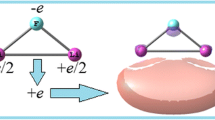Abstract
Quantum chemical calculations using gradient corrected density functional theory at B3LYP level reveals the unusual properties of a chromium (Cr) atom interacting with fluorine (F) atoms. Up to seven F atoms are bound to a single Cr atom, which results in increase of electron affinities as successive fluorine atoms are attached, reaching a peak value of 7.14 eV for CrF6. The large HOMO–LUMO energy gap, both in neutral and anionic form, further provide evidence of their stability. These unusual properties brought about by involvement of inner shell 3d-electrons, which not only allow CrF n (n = 1–7) clusters to belong to the class of superhalogens but also show that its valence can exceed the nominal value of 2.










Similar content being viewed by others
References
Gutsev GL, Boldyrev AI (1981) DVM-Xa calculations on the ionization potentials of [MXk+1]− complex anions and the electron affinities of MXk+1 “superhalogens”. Chem Phys 56:277–283
Gutsev GL, Boldyrev AI (1985) The theoretical investigation of the electron affinity of chemical compounds (review). Adv Chem Phys 61:169–221
Gutsev GL, Boldyrev AI (1984) The electronic structure of the 3d- and 4d-metal hexafluoride anions and the electron affinities of the corresponding neutrals. Mol Phys 53:23–31
Gutsev GL, Bartlett RJ, Boldyrev AI, Simons J (1997) Adiabatic electron affinities of small superhalogens: LiF2, LiCl2, NaF2, and NaCl2. J Chem Phys 107:3867–3875
Wang XB, Ding CF, Wang LS, Boldyrev AI, Simons J (1999) First experimental photoelectron spectra of superhalogens and their theoretical interpretations. J Chem Phys 110:4763–4771
Gutsev GL, Rao BK, Jena P, Wang XB, Wang LS (1999) Origin of the unusual stability of MnO4 −. Chem Phys Lett 312:598–605
Gutsev GL, Khanna SN, Rao BK, Jena P (1999) FeO4: a unique example of a closed-shell cluster mimicking a superhalogen. Phys Rev A59:3681–3684
Scheller MK, Compton RN, Ceederbaum LS (1995) Gas-phase multiply charged anions. Science 270:1160–1166
Compton RN, Reinhardt PW (1980) Reactions of fast cesium atoms with polymers of antimony pentafluoride and gold pentafluoride. J Chem Phys 72:4655–4656
Graudejus O, Elder SH, Lucier GM, Shen C, Bartlett N (1999) Room temperature syntheses of AuF6 − and PtF6 − salts, Ag+AuF6 −, Ag2+PtF6 2−, and Ag2+PdF6 2−, and an estimate for E(MF6 −) [M = Pt, Pd]. Inorg Chem 38:2503–2509
Lucier GM, Shen C, Elder SH, Bartlett N (1998) Facile routes to NiF6 2−, AgF4 −, AuF -6 , and PtF6 − salts using O2 + as a source of O2F in anhydrous HF. Inorg Chem 37:3829–3834
Riedel S, Kaupp M (2006) Has AuF7 Been Made? Inorg Chem 45:1228–1234
Himmel D, Riedel S (2007) After 20 years, theoretical evidence that “AuF7” is actually AuF5·F2. Inorg Chem 46:5338–5342
Compton RN (1978) Collisional ionization between fast alkali atoms and selected hexafluoride molecules. J Chem Phys 68:2023–2036
Leary K, Bartlett N (1972) A new oxidation state of gold: the preparation and some properties of [AuF6]-salts. J Chem Soc 15:903–904
Lucier GM, Whalen JM, Bartlett N (1998) High yield room temperature syntheses of KAgF4 and AgF3 and the preparation and unit cell of LiAgF4. J Fluor Chem 89:101–104
Rienstra-Kiracofe JC, Tschumper GS, Schaefer HF III, Nandi S, Ellison GB (2002) Atomic and molecular electron affinities: photoelectron experiments and theoretical computations. Chem Rev 102:231–282
Becke BD (1993) Density‐functional thermochemistry. III. The role of exact exchange. J Chem Phys 98:5648–5652
Kolboe S, Svelle S (2008) Does an ethene/benzenium ion complex exist? A discrepancy between B3LYP and MP2 predictions. J Phys Chem A112:6399–6400
Frisch MJ, Trucks GW, Schlegel H B, Scuseria GE, Robb M A, Cheeseman JR, Montgomery JA, Jr., Vreven T, Kudin KN, Burant JC, Millam JM, Iyengar SS, Tomasi J, Barone V, Mennucci B, Cossi M, Scalmani G, Rega N, Petersson GA, Nakatsuji H, Hada M, Ehara M, Toyota K, Fukuda R, Hasegawa J, Ishida M, Nakajima T, Honda Y, Kitao O, Nakai H, Klene M, Li X, Knox J E, Hratchian HP, Cross JB, Adamo C, Jaramillo J, Gomperts R, Stratmann RE, Yazyev O, Austin AJ, Cammi R, Pomelli C, Ochterski JW, Ayala PY, Morokuma K, Voth GA, Salvador P, Dannenberg JJ, Zakrzewski VG, Dapprich S, Daniels AD, Strain MC, Farkas O, Malick DK, Rabuck AD, Raghavachari K, Foresman JB, Ortiz JV, Cui Q, Baboul AG, Clifford S, Cioslowski J, Stefanov BB, Liu G, Liashenko A, Piskorz P, Komaromi I, Martin RL, Fox DJ, Keith T, Al-Laham MA, Peng CY, Nanayakkara A, Challacombe M, Gill PMW, Johnson B, Chen W, Wong MW, Gonzalez C and Pople JA (2003) Gaussian 03. Revision A.1. Gaussian, Inc., Pittsburgh PA
Paquette JA, Ipavich FM, Lasley SE, Bochsler P, Wurz P (2001) The relative abundance of chromium and iron in the solar wind. AIP Conf Proc 598(21):95–99
Pople JA, Head-Gordon M, Fox DJ, Raghavachari K, Curtiss LA (1989) Gaussian‐1 theory: general procedure for prediction of molecular energies. J Chem Phys 90:5622–5629
Dibeler VH (1969) Dissociation energy of fluorine. J Chem Phys 50:4592–4593
Costales A, Kandalam AK, Pandey R (2003) Theoretical study of neutral and anionic group III nitride clusters : MnNn (M = Al, Ga and In; n = 4–6). J Phys Chem B107:4508–4514
Li SF, Gong XG (2006) Neutral and negatively charged A112X (X = Si, Ge, Sn, Pb) clusters studied from first principles. Phys Rev B74:45432–45436
Author information
Authors and Affiliations
Corresponding author
Rights and permissions
About this article
Cite this article
Siddiqui, S.A. First principle study of CrF n (n = 1–7) nano clusters: An investigation of superhalogen properties. Struct Chem 23, 267–274 (2012). https://doi.org/10.1007/s11224-011-9871-3
Received:
Accepted:
Published:
Issue Date:
DOI: https://doi.org/10.1007/s11224-011-9871-3




